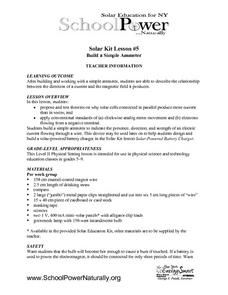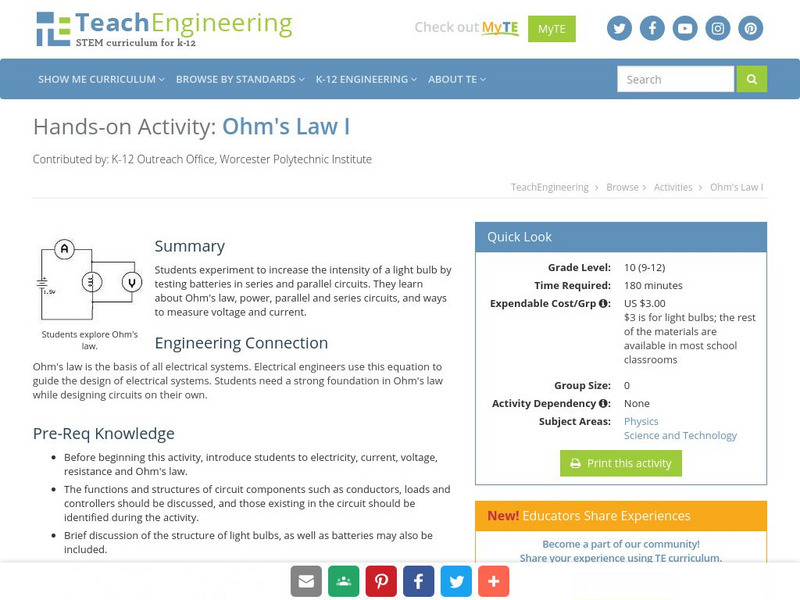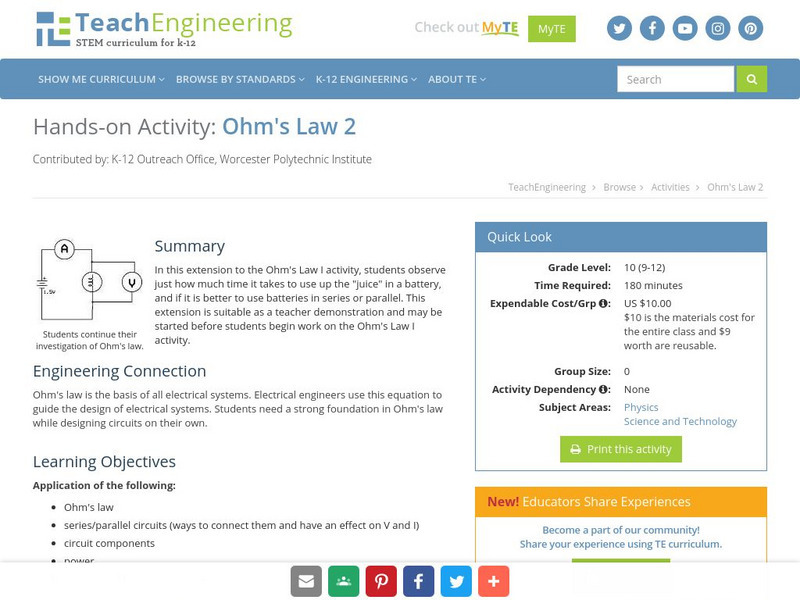Curated OER
Please Turn Up the Lights!
Eighth graders discuss series and parallel circuits and design an investigation to test a hypothesis on total resistance of series and parallel circuits in combination. After discussion, groups design their experiments, run tests, and...
Curated OER
Build a Simple Ammeter
Students build and work with a simple ammeter to test theories on why solar cells connected in parallel produce more current that in series. Students use the ammeter to indicate the presence, direction, and strength of an electric...
Curated OER
Ohm's Laws
Learners explore the relationship of resistance, voltage and current in series and parallel circuits. Then they discover Ohm's Law by constructing series circuits with one resistor and putting the resultant resistance, current and...
Curated OER
TE Activity: Ohm's Law 2
Students study Ohm's Law 2 after completing an activity about Ohm's Law 1. They determine how long it takes to charge a battery. They examine if it is better to use batteries in series or parallel circuits.
Other
Tech Topics: Electricity: Circuits
What is a circuit? How does it work? The animated diagrams and accompanying text will make it easy to understand the concept of circuits!
TeachEngineering
Teach Engineering: Bulbs & Batteries Side by Side
We are surrounded everyday by circuits that utilize "in parallel" and "in series" circuitry. Complicated circuits designed by engineers are made of many simpler parallel and series circuits. In this hands-on activity, students build...
TeachEngineering
Teach Engineering: Ohm's Law I
Students will work to increase the intensity of a light bulb by testing batteries in series and parallel circuits. It analyzes Ohm's Law, power, parallel and series circuits, and ways to measure voltage and current.
TeachEngineering
Teach Engineering: Introduction to Circuits and Ohm's Law
Students will explore the basics of dc circuits analyzing the light from light bulbs when connected in series and parallel circuits. Ohm's Law and the equation for power dissipated by a circuit will be the primary equations used. Using...
CK-12 Foundation
Ck 12: Resistors in Series and Parallel
[Free Registration/Login may be required to access all resource tools.] The differences between series and parallel circuits are highlighted. Provides an in-depth look at how to solve problems about circuits and resistors. Includes a...
Physics Classroom
The Physics Classroom: Current Electricity: Combination Circuits
Explains what a combination circuit is, reviews the features of series and parallel circuits, and demonstrates how to analyze combination circuits. Includes detailed examples and some problems for students to try. There is also a link to...
CK-12 Foundation
Ck 12: Parallel Circuits
[Free Registration/Login may be required to access all resource tools.] In this module, students learn what a parallel circuit is and how it differs from a series circuit.
University of Guelph
University of Guelph: Physics Tutorials: Dc Circuits: Resistors in Parallel
Explains and illustrates the meaning of parallel connections. Discusses the voltage-current-resistance relationships for parallel connections of resistors. An example problem on parallel calculations can be accessed from this page.
Science and Mathematics Initiative for Learning Enhancement (SMILE)
Smile: Exploring Series and Parallel Circuits
The Illinois Institute of Technology provides a great classroom activity for exploring series and parallel circuits.
Science Education Resource Center at Carleton College
Serc: Investigating Electricity: Building Circuits in Elementary Science Class
In this exploration activity, students compare the difference between series circuits and parallel circuits using wire, light bulbs, and D batteries.
TryEngineering
Try Engineering: Series and Parallel Circuits
The core of this lesson is simple circuits and the differences between parallel and series circuit design. Students perform experiments to test the differences between the two circuit designs using low voltage light bulbs.
Wikimedia
Wikipedia: Series and Parallel Circuits
Wikipedia offers information on two basic ways of wiring components in electrical circuits, series and parallel circuits.
TeachEngineering
Teach Engineering: Ohm's Law 2
This extension to the Ohm's Law I activity, students will observe just how much time it takes to use up the "juice" in a battery, and if it is better to use batteries in series or parallel.
TeachEngineering
Teach Engineering: Many Paths
Learners explore the composition and practical application of parallel circuitry, compared to series circuitry. Students design and build parallel circuits and investigate their characteristics, and apply Ohm's law.
Physics Aviary
Physics Aviary: Practice Problems: Parallel of Capacitors in Series
Determine the total energy stored on a group of capacitors in a combination circuit.
Exploratorium
Exploratorium: The Tinkering Studio: Circuit Boards
Some history behind the function of the circuit board, with a guided activity guide for students to download.
Physics Aviary
Physics Aviary: Parallel Circuit Lab
This lab is designed to have students investigate the relationships between voltage, resistance and current in a parallel circuit with up to three passive components. The batteries in this simulation can be varied from ideal batteries to...
Concord Consortium
Concord Consortium: Dc Circuits: Parallel Resistances (Sparks 2)
Explore circuits with resistors in parallel and answer questions regarding voltage drops across resistors and currents through them in such circuits.
Physics Classroom
The Physics Classroom: Electric Circuits: Circuit Connections: Parallel Circuits
When two or more electrical devices in a circuit are connected, it is known as a series connection or a parallel connection. When all the devices are connected using parallel connections, the circuit is referred to as a parallel circuit....
CK-12 Foundation
Ck 12: Physical Science: Series and Parallel Circuits
[Free Registration/Login may be required to access all resource tools.] What series and parallel circuits are and how they differ.





















